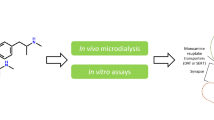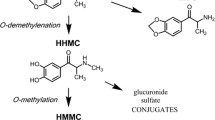Abstract
Hydroxymescaline (HM) and Β-phenylethylamine (PEA) affected the conditioned-avoidance responses (CAR) in rats after i.p. injection of 100 mg/kg and 40 mg/kg, respectively. The fates of these two compounds and of 2,3,4,5,6-pentamethoxyphenylethylamine (PMPEA), a behaviorally active mescaline derivative, and of 2,4,5-trimethoxyphenylethylamine (TMPEA), a behaviorally inactive compound, were studied in rats. All compounds are quickly absorbed and distributed after i.p. injection and are also quickly removed from brain, liver and plasma. The compounds cross the blood-brain barrier differently and TMPEA could not be detected in the CNS explaining, perhaps, its lack of behavioral activity. A comparison of the minimal doses (Μmoles/kg) of these compounds which affect the CAR in rats is: PMPEA (10)>mescaline (60)>PEA (240)>HM (420). In contrast, a comparison of minimal brain levels necessary to affect the CAR reveals the following relationship (nmoles/g) PMPEA (1.8)>mescaline (2.4)>Hm=PEA (40). It is suggested that SAR studies with psychoactive compounds should not be based on injected doses but on actual brain levels at periods of abnormal behavior.
Similar content being viewed by others
References
Cohen, I., Vogel, W. H.: An assay procedure for mescaline and its determination in rat brain, liver and plasma. Experientia (Basel) 26, 1231–1232 (1970)
Ernst, A. M.: Relation between the action of dopamine and apomorphine and their O-methylated derivatives upon the CNS. Psychopharmacologia (Berl.) 7, 391–399 (1965)
Lewin, L.: Phantastica-narcotic and stimulating drugs, their use and abuse. London: Kegan Paul, Trench, Trubner & Co., Ltd. 1931
Mantegazza, P., Riva, M.: Amphetamine-like activity of Β-phenylethylamine after a monoamine oxidase inhibitor in vivo. J. Pharm. Pharmacol. 15, 472–478 (1963)
Pardridge, W. M., Connor, J. D.: Saturable transport of amphetamine across the blood-brain barrier. Experientia (Basel) 29, 302–304 (1973)
Sachs, C.: Failure of 6-hydroxynorepinephrine to produce degeneration of catecholamine neurons. Europ. J. Pharmacol. 20, 149–155 (1972)
Smythies, J. R., Sykes, E. A.: Structure-activity relationship studies on mescaline: The effect of dimethoxyphenylethylamine and N,N-dimethylmescaline on the conditioned-avoidance response in the rat. Psychopharmacologia (Berl.) 8, 324–330 (1966)
Smythies, J. E., Johnston, V. S., Bradley, R. J.: Behavioral models of psychosis. Brit. J. Psychiat. 115, 55–68 (1969)
Author information
Authors and Affiliations
Rights and permissions
About this article
Cite this article
Cohen, I., Fischer, J.F. & Vogel, W.H. Physiological disposition of Β-phenylethylamine, 2,4,5-trimethoxyphenylethylamine, 2,3,4,5,6-pentamethoxyphenylethylamine and Β-hydroxymescaline in rat brain, liver and plasma. Psychopharmacologia 36, 77–84 (1974). https://doi.org/10.1007/BF00441384
Received:
Issue Date:
DOI: https://doi.org/10.1007/BF00441384




